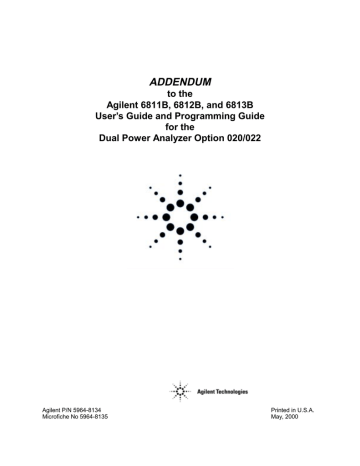Verification Procedure. Agilent Technologies 6811B, 6813B, 6812B, 5964-8134
Add to my manuals
26 Pages
advertisement

Verification Procedure
The following verification procedures assume you understand how to operate the ac source from the front panel as explained in chapter 4.
Perform the following tests for operation verification in the order indicated.
1. Turn-On Checkout
2. Voltage Measurement Accuracy
3. Current Measurement Accuracy
NOTE:
Test Set up
The ac source must pass turn-on selftest before you can proceed with the verification.
Agilent 6811B/6812B/6813B
LO HI | LO HI
I
SENSE
V
SENSE
POWER ANALYZER
HI
Agilent 3458A
DMM 01
MAIN OUTPUT
SENSE
01 COM COM
LO
Rs R
L
Rs = Current Monitor resistor (0.01 ohms)
A.
Agilent 3458A
HI
DMM
LO
Agilent 33120A
FUNCTION GENERATOR
Agilent 6811B/6812B/6813B
LO HI | LO HI
I
SENSE
V
SENSE
POWER ANALYZER
Agilent 3458A
DMM
HI
LO
C1
01
MAIN OUTPUT
SENSE
01 COM COM
B.
C1 = Capacitor (1.0 uF)
Figure B-1. Verification / Calibration Test Setup
23
Power Analyzer Voltage Measurement Accuracy
This test verifies the accuracy of the Power Analyzer voltage measurements. The Phase 2 annunciator on the left side of the display, must be on for the front panel to display Power Analyzer input measurements.
Figure B-1A shows the setup. Measure the ac output voltage directly at the output terminals.
Action Normal Result
1.
Make sure the ac source is turned off. Connect the DVM to the output terminals the ac source. Connect the Power Analyzer voltage sense terminals
(V SENSE) to the Main Output terminals of the ac source (see figure B-1A).
2.
Turn on the ac source with no load. In the Output menu, execute the *RST command to reset the unit to its factory default state.
3.
If the Phase 2 annunciator does not appear on the right side of the display, press the Phase Select key.
4.
Program the output voltage to 150 volts and set the output current limit to its maximum value.
5.
Enable the output by pressing Output On/Off .
6.
Record voltage readings at the DVM and on the front panel display.
7.
Program the output voltage to 300 volts.
8.
Record voltage readings at the DVM and on the front panel display.
*RST
φ
2 0 V 60 Hz
CV annunciator on.
Output voltage near 150 V.
φ
2 front panel reading within
145 mV of DVM reading .
Output voltage near 300 V.
φ
2 front panel reading within
190 mV of DVM reading
Power Analyzer Current Measurement Accuracy
This test verifies the accuracy of the Power Analyzer current measurements. The Phase 2 annunciator on the left side of the display, must be on for the front panel to display Power Analyzer input measurements.
Figure B-1A shows the setup. Use the Agilent supplied current shunt. It has the accuracy specified in table B-1. Use wire of sufficient size to carry the maximum rated current of the ac source.
NOTE: Check to make sure that the internal shunt value in the ac source matches the value written on the external current shunt. Refer to "Check the Shunt Value Setting".
Normal Result Action
1.
Turn off the ac source. Connect the 30 ohm load resistor, current shunt, and the DVM across the current shunt. Connect the Power Analyzer current terminals (I SENSE) to the output of the function generator (see figure B-1A).
2.
Turn on the ac source. In the Output menu, execute the *RST command to reset the unit to its factory default state.
3.
If the Phase 2 annunciator does not appear on the right side of the display, press the Phase Select key.
4.
Program the output voltage to 100 volts and set the current limit to 3 amperes. Enable the output by pressing Output On/Off .
5.
Record the DVM voltage reading and calculate the rms current. Divide the
DVM reading by the current monitor resistor value. Record the front panel reading.
*RST
φ
2 0 V 60 Hz
CC annunciator on.
Output current near 3 amperes
φ
2 front panel reading within
11.5 mA of measured output current.
24
advertisement
* Your assessment is very important for improving the workof artificial intelligence, which forms the content of this project
Related manuals
advertisement
Table of contents
- 2 Table of Contents
- 3 Dual Power Analyzer Description
- 5 Rear Panel Connections
- 5 Installation
- 8 Front Panel Programming
- 10 Additional Measurement Commands
- 12 Additional Sense Commands
- 13 Additional Frequency Modulation Commands
- 14 Additional Calibration Commands
- 15 Behavior Differences of Existing SCPI Commands
- 16 Programming Example
- 17 Using the Power Analyzer Input with the GUI
- 20 Power Analyzer Input Specifications
- 22 Verification and Calibration for Option 020/022
- 23 Verification Procedure
- 25 Calibration Procedure